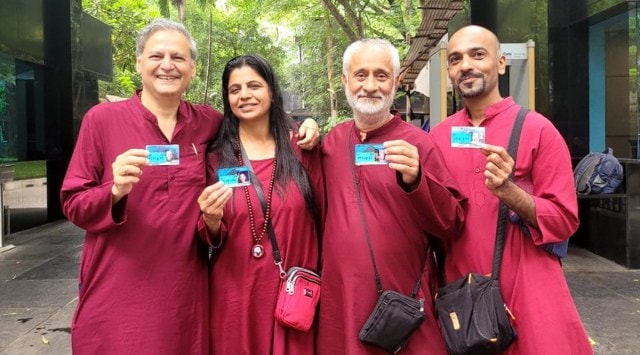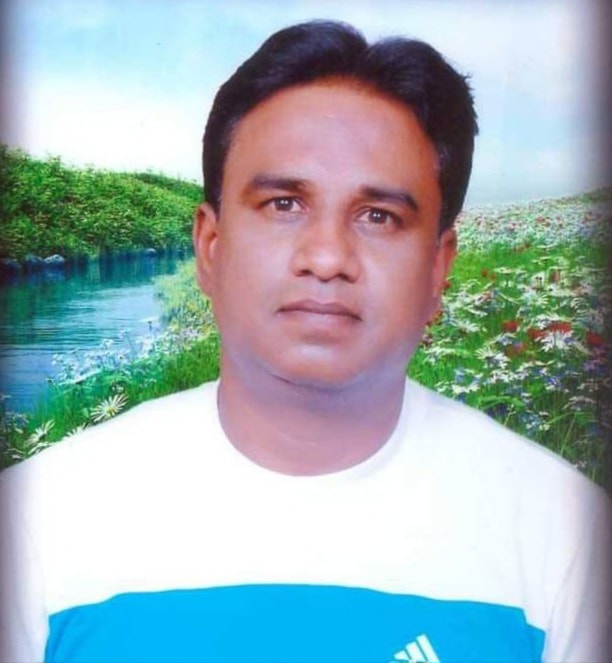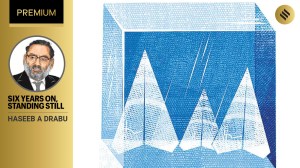Click here to join Express Pune WhatsApp channel and get a curated list of our stories
Banned for ‘anti-resort activities’, disciples visit Osho samadhi after Bombay HC order
"It was like a sweet home-coming for me after a good 11 years. I and at least six other Osho disciples walked inside with pride and with our heads held high," said Yogesh Thakkar.
 Thakkar was among those banned in 2011 for indulging in "anti-resort activities."(Express photo)
Thakkar was among those banned in 2011 for indulging in "anti-resort activities."(Express photo)Twelve years after he was “banned” by the Osho International Meditation Resort, popular by its old name Osho Ashram among the locals and located in Pune’s upmarket Koregaon Park area, 65-year-old Yogesh Thakkar, known among disciples as Swami Premgeet, on Tuesday got an opportunity to visit the samadhi of his guru Osho. The spiritual mystique first shot to fame in the 1970s.
“It was like a sweet home-coming for me after a good 11 years. I and at least six other Osho disciples walked inside with pride and with our heads held high,” Thakkar told The Indian Express as he walked out of the ‘Resort’ gate.
“It was a heavenly bliss to visit my guru’s samadhi. Had it not been for the honourable Bombay High Court, this would not have been possible,” added Thakkar, his voice choking with emotions. “I was given ‘diksha’ by Osho himself in 1979. I have spent nearly 14 years of my life in the Osho Commune.”
Thakkar was among those banned in 2011 for indulging in “anti-resort activities.” Describing his ban as unjustified, Thakkar said, “Firstly, it is not a ‘resort’ as they are calling it. We call it Osho Commune or Osho Ashram. This is how it is known world over. Secondly, anyone who highlights or exposes the wrongdoings of those who are at the helm are banned from entering or visiting Osho samadhi. When we are trying to protect Osho’s legacy, his thoughts, his ideas, his philosophy, how can they ban us?”
Thakkar and a few other disciples had in 2011 filed a complaint with the Charity Commissioner’s office against the alleged attempt of the Osho International Foundation, a trust which runs the “Resort”, to gift a part of its property to an obscure trust from Delhi. “After we learnt that 56,000 square feet property has already been transferred to the obscure trust, we moved the Bombay High Court which put a stay on the deal in 2012. The stay continues till date,” said Thakkar, adding that since November 2011, he was banned from entering the ashram premises.
In 2021, Thakkar and other disciples under the banner of Osho Friends International moved the Bombay High Court against the alleged attempts by the Osho International Foundation to sell a part of the property to a prominent industrialist. The matter is pending before the high court. Thakkar had also brought it to the notice of the high court that the resort was stopping the devotees from visiting Osho’s samadhi.
On August 11, the Bombay high court passed an order stopping the sale of the resort’s property and allowed the devotees to the visit Osho samadhi.
In its order, the high court has said, “Neither the respondents nor any party shall alienate or create any third party interest in respect of the movable or immovable property of the Trust without following due process of law. It is also made clear that there is no prohibition for the Petitioners or devotees to visit the Samadhi. The directions are also given to protect the Osho Samadhi. The Petitioners or devotees certainly can visit the Osho Samadhi. It is open for the Petitioners to bring it to the notice of the Committee conducting an enquiry, any other factual matrix including the properties of the trust, so as to include in Schedule-I, which can certainly be considered by the Committee and also the Joint Charity Commissioner.”
However, on Sunday, when Thakkar and a few other disciples, armed with the copy of the high court order, tried to enter the resort, they were not allowed to enter. “There was nobody at the Welcome Centre of the resort to issue us the entry pass and get us registered,” said Thakkar. “Today, however, our names were registered and we were allowed to enter the samadhi. But we were charged Rs 970 as entry fee despite the fact that the court has said that there should be no prohibition on the visit of the devotees,” he alleged.
Swami Chaitanya Keerti, who was among the first ones to be banned way back in 2001, said, “It is indeed a big moment for us ‘rebels’. Over a period of 20 years, I think at least 500 devotees who raised their voice against the wrongdoings of those controlling the affairs of the commune had to suffer ouster and were kept away from the guru’s legacy.”
Swami Keerti said, “We have, from time to time, been raising our voice against the transfer of Osho’s intellectual property like audio and video cassettes of his discourses, pravachans to Zurich, transfer of ownership in the hands of a few foreigners and imposition of entry fee of Rs 970 even on long-time members. We will keep fighting to keep Osho’s legacy intact and not allow it to be misused by a few foreigners for their vested interests.”
When approached for comments, Ma Amrit Sadhana, spokesperson of Osho International Meditation Resort, said, “In the wake of the high court order, we are allowing entry to those who were banned earlier. These people were banned for their anti-resort activities.”
Click here to join Express Pune WhatsApp channel and get a curated list of our stories













